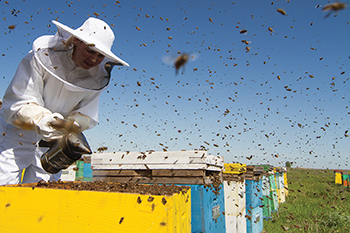
When I was only knee-high to a goat, my grandfather took me for long rides each evening at dusk. He loaded me into in his Chevy just as the deer began to venture from the woods into the orchards for dinner. He loved to watch them, excitedly calling, “Look there! One, two, three…”
I loved those outings through the farmland, especially as mist settled into the lowlands between the hills, shrouding the fields in mystery. But as he counted deer, I hunted for something else entirely. Bee hives. With my window rolled down, I would climb halfway out, balancing on my belly and inhaling the aroma of fresh-cut hay and warm manure, intently searching for hives as the countryside slid by.
Although I didn’t know it at the time, the objects of my fascination were Langstroths. Every last one of them. They stood at cockeyed angles, tilting one way and another, coated with heavy layers of lead paint that flaked off in chalky curls. Every farm had a few, usually perched on the edge of a field, curiously white through the descending mist. Although some were tall and others short, all bee hives had the same basic shape.
The Test of Time
The Reverend Lorenzo Lorraine Langstroth registered the patent for his hive in October 1852. By his own admission, Langstroth borrowed freely from the work of his predecessors, including François Huber’s leaf hive. Although disagreement continues about who first defined bee space and who first cottoned onto moveable-frame hives, the fact remains that Langstroth incorporated these concepts into a hive design that was affordable, easy to use, and highly customizable.
Few inventions have stood the test of time as well as the Langstroth hive, and today—166 years later—variations of it are still used around the globe. In North America, it continues to be the hive of choice for large commercial operations and beginners alike.
Variations on a Theme
Langstroth’s vision of modular boxes containing moveable frames that honored bee space on all sides allowed beekeepers to inspect, harvest, and split colonies without destroying the bees or their living quarters. Although we may not realize it, many other modern hive designs—including the National, Warré, and Flow—are simply variations on the Langstroth.
The National, primarily used in the UK, has smaller boxes that are square, along with many minor tweaks. The Warré hive is sometimes called a vertical top-bar hive, but the idea of modular boxes that sit one atop another and respect bee space, comes straight from the Langstroth playbook. And the Flow Hive is a contemporary Langstroth hive topped with a self-extracting honey super.
The Beginning of an Industry
Just as the invention of the semiconductor precipitated a flood of innovation, so did the introduction of the Langstroth hive. Once the value of the hive became apparent, it was followed by the radial extractor, the queen excluder, and the hand-held smoker—all of which are still used today. Other related inventions included self-spacing frames, the foundation press, and the screened bottom board for controlling wax moth infestations. The synergistic development of tools to be used with the Langstroth cemented its place in beekeeping history. No other hive design offered anything close for practicality and ease of use. In fact, it is the Langstroth hive that led to the development of large-scale commercial beekeeping.
For the migratory beekeeper, Langstroth hives are perfect. They are stackable, palletable, and can be moved with a forklift. They can be transferred to any location and retrieved when the job is done. In addition, boxes can be exchanged between hives and frames between boxes. Like Gutenberg’s moveable-type printing press, the Langstroth hive allows endless combinations. There is no limit to the number of changes and tweaks that a beekeeper can make.
My Adventures with a Top-Bar Hive
My admiration for the Langstroth hive increased after managing a top-bar hive. My experience with a top-bar hive began ten years ago with a prototype design that we were planning to use at a state prison. I wanted to practice with it before ….


